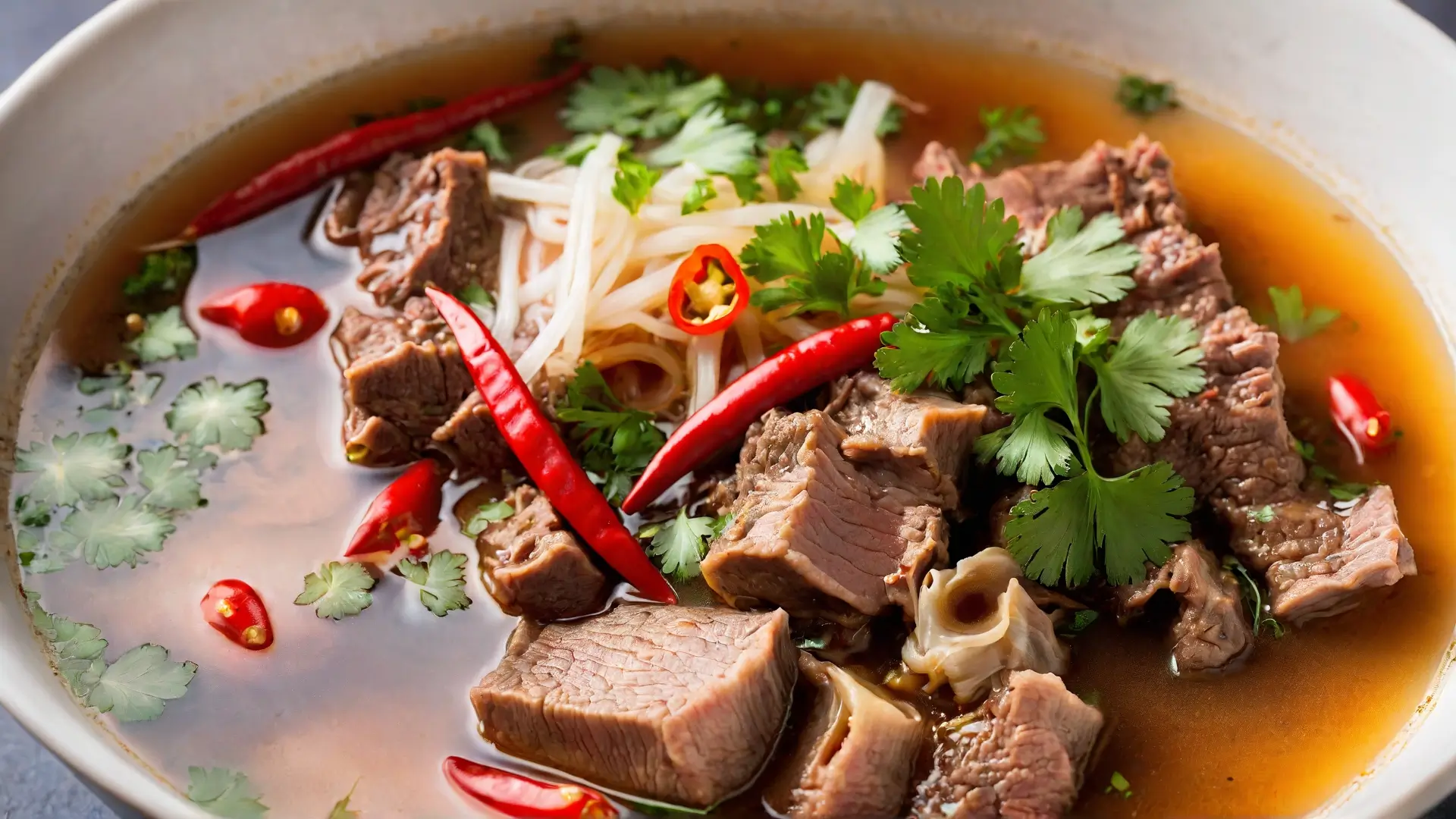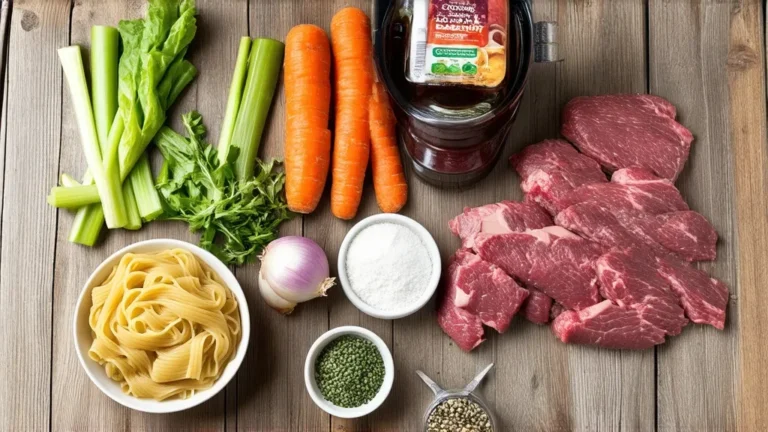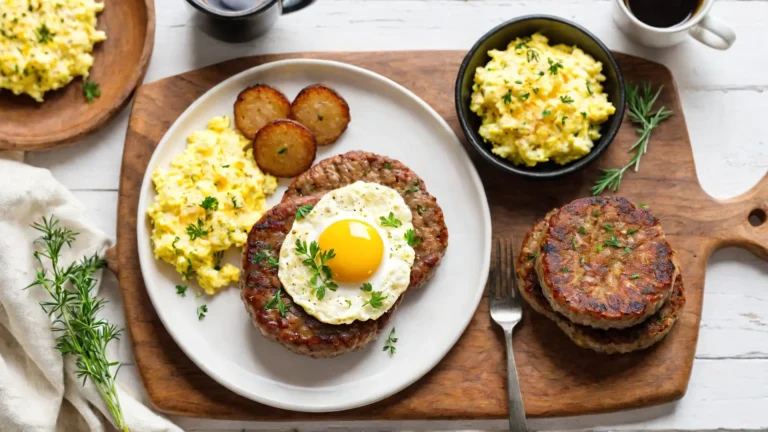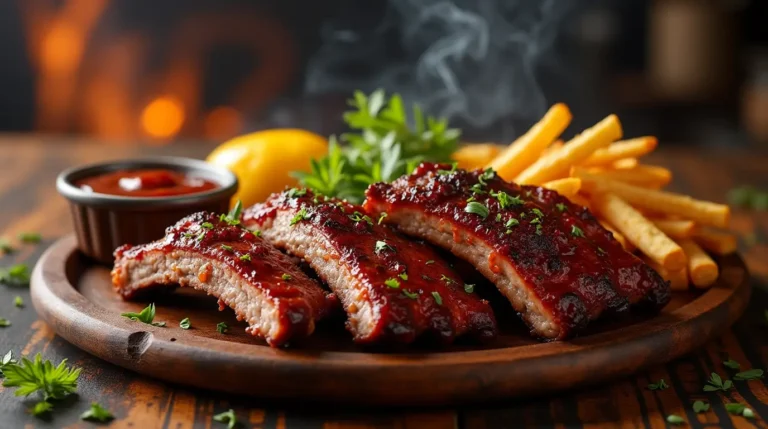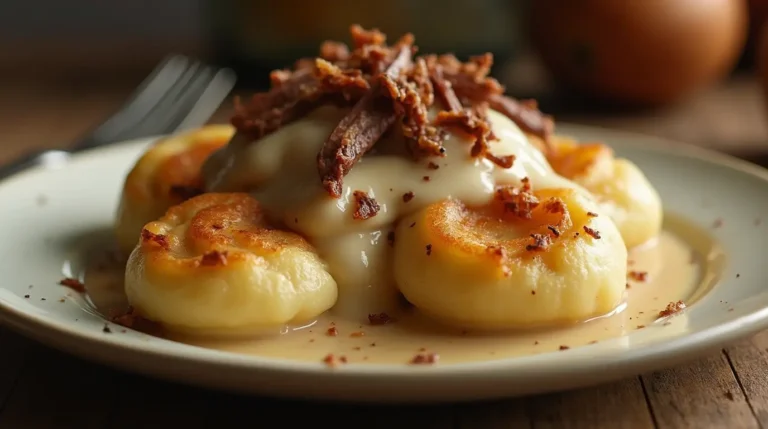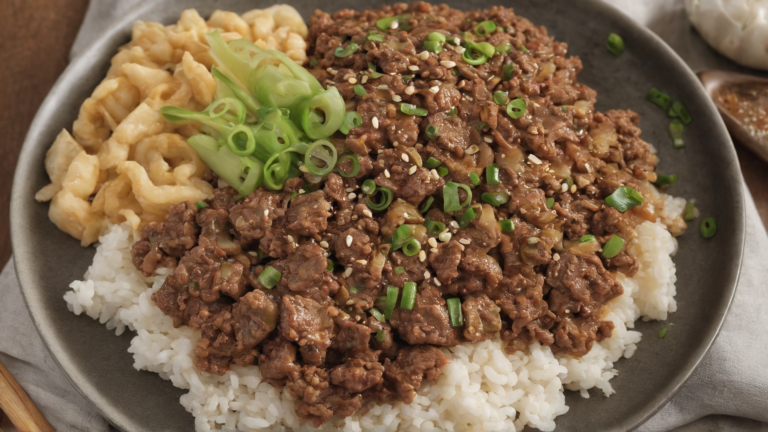How to Make Tender and Gelatinous Beef Tendon at Home
Beef tendon is a special dish known for its unique texture and taste. To make it tender and gelatinous, you need the right recipe and techniques. Learning to cook beef tendon is rewarding, and with the right help, anyone can do it.
Beef tendon is great for special events or everyday meals. You can cook it using traditional Chinese braising or pressure cooking.
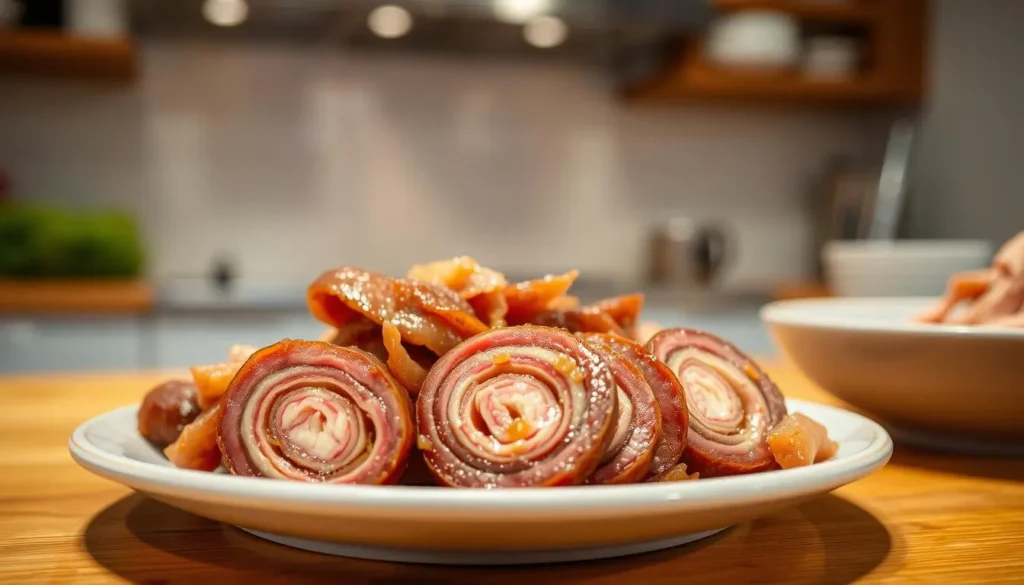
Cooking beef tendon at home needs some knowledge and practice. But with effort, you can get results like a pro. Whether you want a classic recipe or something new, there are many resources to help you.
This article will guide you on how to cook beef tendon at home. You’ll learn about different cooking methods to make it tender and gelatinous.
Introduction to Beef Tendon Cooking
Cooking beef tendon is an art that needs patience, skill, and the right ingredients. By following a simple recipe and using the right techniques, you can make a delicious dish. This article will cover various cooking methods, including traditional Chinese braising, pressure cooking, and slow cooking.
Key Takeaways
- Beef tendon is a collagen-rich delicacy that requires special cooking techniques to achieve tender and gelatinous results.
- Following a good beef tendon recipe is essential to achieving professional-like results.
- Cooking beef tendon at home can be a rewarding experience with the right guidance and practice.
- There are various methods for cooking beef tendon, including traditional Chinese braising, pressure cooking, and slow cooking.
- A tender beef tendon dish can be prepared using a simple beef tendon recipe and the right ingredients.
- Cooking beef tendon requires patience, skill, and the right ingredients to achieve the perfect results.
- With practice and the right techniques, anyone can master the art of cooking tender and gelatinous beef tendon at home.
Understanding Beef Tendon: A Collagen-Rich Delicacy
Beef tendon is a type of connective tissue packed with collagen. It’s a favorite in many cuisines, like Asian cooking. The beef tendon benefits are many, thanks to its low fat and high protein. It’s a great choice for a healthy diet.
Making homemade beef tendon lets you pick the ingredients and cooking methods. This way, you get the most nutritional value from it. Collagen-rich foods like beef tendon help keep your skin, hair, and nails healthy. Adding beef tendon to your meals can bring many health benefits.
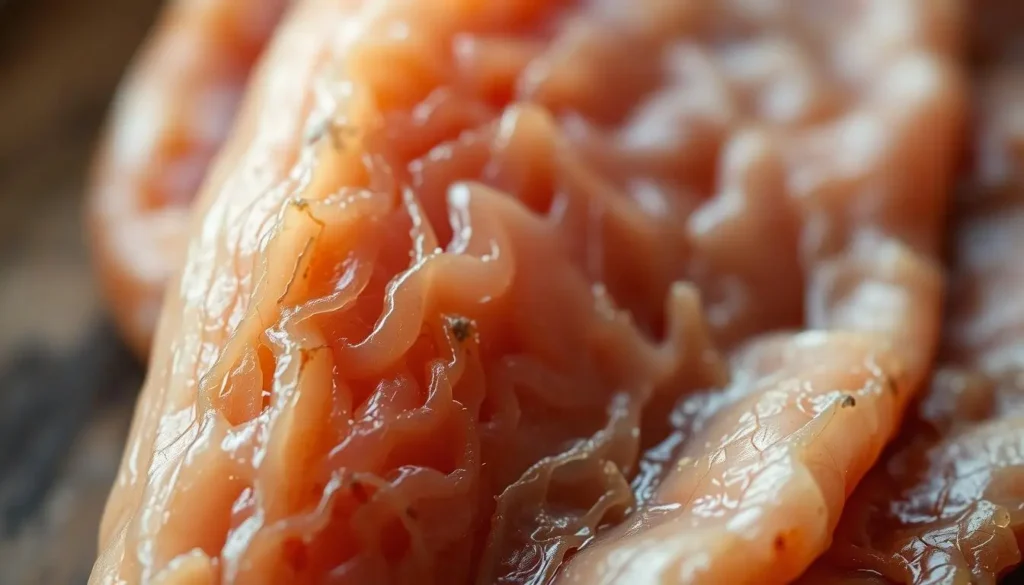
- Control over ingredients and cooking methods
- Ability to customize flavor and texture
- Cost-effective compared to restaurant options
Learning about beef tendon’s benefits and versatility opens up new ways to enjoy it. You can start experimenting with different recipes and flavors.
Essential Tools and Ingredients for Cooking Beef Tendon
To make a tasty beef tendon recipe, you need the right tools and ingredients. A big pot or slow cooker is key for even cooking and tenderizing. Also, a strainer or colander helps with draining, and a sharp knife is needed for slicing.
For ingredients, onions, garlic, and ginger are common in beef tendon recipes. They add flavor and can be sautéed in oil to enhance their taste. Soy sauce, sugar, and seasonings are also important for a rich sauce. Following some simple tips can make your dish stand out.
Tools like a meat thermometer and whisk are also helpful. They ensure the meat is cooked right and help mix the sauce. With these tools and ingredients, you’re ready to make a delicious beef tendon dish.
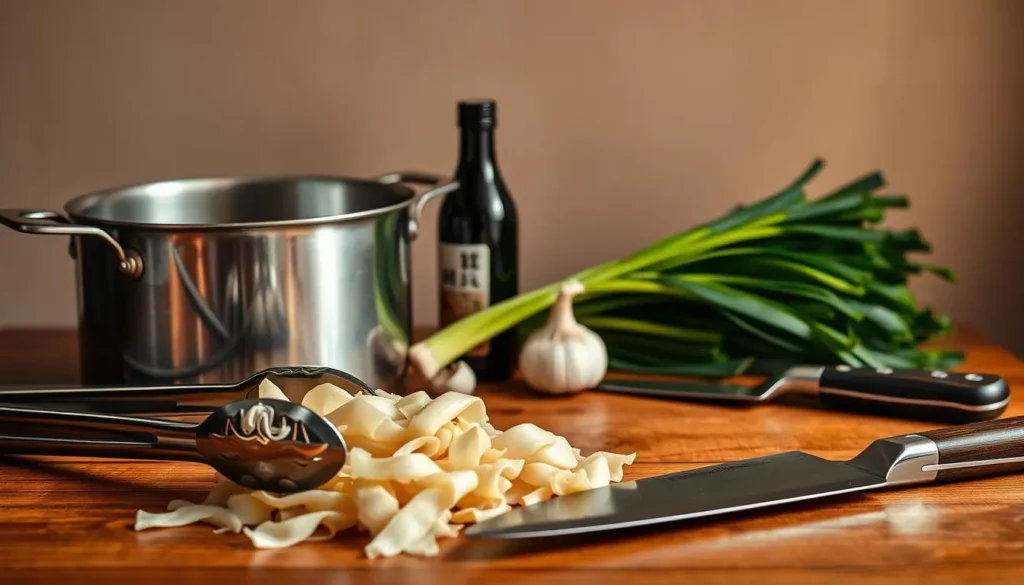
Here are some key ingredients for beef tendon:
- Beef tendon
- Aromatics like onions, garlic, and ginger
- Soy sauce and sugar
- Various seasonings
Having these ingredients lets you try different beef tendon recipes. From traditional Chinese dishes to modern twists, you can experiment and master cooking beef tendon. With practice, you’ll enjoy this tasty and healthy ingredient in new ways.
Preparing Your Beef Tendon for Cooking
To get tender and gelatinous results, you must prepare your beef tendon right. This step is key to remove extra fat and connective tissue. These can make the tendon tough and chewy. Cleaning and trimming the tendon ensures it cooks evenly and soaks up flavors well.
A slow-cooked beef tendon is a special dish that needs patience and care. First, clean and trim the tendon to remove fat and connective tissue. This makes the tendon cook evenly and prevents toughness. Then, cut the tendon into the right size pieces for your desired texture and look.
Here are some tips for preparing your beef tendon:
- Clean and trim the tendon to remove excess fat and connective tissue
- Cut the tendon into the right size pieces for even cooking
- Use pre-cooking treatments like blanching or soaking to tenderize the tendon
By following these steps, you can make a tender beef tendon full of flavor and texture. Whether you’re making a gelatinous beef tendon soup or a hearty stew, proper preparation is key to the best results.
| Preparation Method | Description |
| Cleaning and Trimming | Removing excess fat and connective tissue |
| Proper Size Cutting | Cutting the tendon into the right size pieces |
| Pre-cooking Treatments | Using blanching or soaking to tenderize the tendon |
Traditional Chinese Braised Beef Tendon Method
To make a true Chinese braised beef tendon dish, you need top-notch ingredients and old-school cooking ways. The Chinese braised beef tendon method cooks the tendon in a tasty liquid, like stock or wine. It’s mixed with spices and aromatics.
For tender and gelatinous results, cook the tendon for hours or even all night. Use a beef tendon soup with soy sauce, sugar, and star anise. This slow cooking breaks down the tendon’s connective tissues, making it tender and flavorful.
Here are the key ingredients for braised beef tendon:
- Ginger
- Garlic
- Scallions
- Soy sauce
- Sugar
- Star anise
Getting the right texture and taste is all about cooking time and temperature. Cook the tendon at 150°F to 200°F for 2-3 hours, or all night. This ensures it’s tender and gelatinous.
Pressure Cooker Method for Quick and Tender Results
The pressure cooker is a quick way to make tender beef tendon. It cooks the tendon fast and evenly. This makes the tendon tender and gelatinous in a short time. Home cooks can enjoy tender beef tendon without spending hours cooking.
Using a pressure cooker involves cooking the tendon with a bit of liquid and some aromatics. It’s perfect for busy cooks who want tasty results quickly. The tendon can be cooked perfectly in under an hour, ideal for a weeknight dinner.
Some benefits of using a pressure cooker for beef tendon include:
- Quick cooking time: The pressure cooker cooks the tendon up to 70% faster than other methods.
- Easy to use: Just add the tendon, liquid, and aromatics to the cooker and let it work.
- Tender results: The pressure cooker ensures the tendon is cooked evenly and tender.
The pressure cooker method is a quick and easy to cook tender beef tendon. Home cooks can enjoy delicious and tender beef tendon without wasting too much time or effort.
Slow Cooker Beef Tendon Recipe
Using a slow cooker makes a delicious and easy beef tendon dish. It cooks low and slow, making the tendon tender and gelatinous with little effort. This recipe is great for any time and can be flavored with various aromatics and seasonings.
To start, you’ll need beef tendon, broth, and spices. You can find these at most grocery stores or online. Here’s what you’ll need:
- 1 pound beef tendon
- 2 cups broth
- 1 tablespoon soy sauce
- 1 teaspoon garlic powder
- Salt and pepper to taste
Just put the ingredients in the slow cooker and cook on low for 8-10 hours. This recipe is perfect for a weeknight dinner or a special event. Serve it with rice, noodles, or veggies for a complete meal.
Slow cookers are great because they cook while you do other things. Just set it and forget it. You can also change up the recipe by adding different spices or herbs.
For the best texture, cook the beef tendon for 8-10 hours. This makes it tender and gelatinous. You can also add carrots or potatoes to make a hearty stew.
Common Mistakes When Cooking Beef Tendon
When making homemade beef tendon, it’s key to avoid common mistakes. Overcooking or undercooking can make the tendon tough or chewy. To get it tender and gelatinous, follow cooking tips for beef tendon and adjust cooking time and temperature.
Using the wrong cooking liquid or seasonings is another mistake. It can ruin the beef tendon benefits. Use a flavorful broth or stock and the right seasonings to improve taste and texture. Also, not preparing the tendon right before cooking can lead to poor results.
Some common mistakes to avoid when cooking beef tendon include:
- Not trimming the tendon properly before cooking
- Using low-quality ingredients that can affect the flavor and texture
- Not monitoring the cooking time and temperature
By following these cooking tips for beef tendon and avoiding common mistakes, you can make a tasty and healthy dish. Whether it’s a traditional Chinese braised beef tendon or a homemade beef tendon recipe, success comes from paying attention to detail and experimenting with techniques.
Health Benefits of Including Beef Tendon in Your Diet
Beef tendon is packed with nutrients, making it great for your health. It’s full of collagen, which is good for your skin and joints. Eating beef tendon regularly can make your skin look younger and more vibrant.
Beef tendon is also rich in protein and minerals like calcium and phosphorus. These are key for strong bones and teeth. Homemade beef tendon is easy to add to many dishes, like soups, stews, salads, and stir-fries.
- Improved skin health and appearance
- Reduced joint pain and inflammation
- Stronger bones and teeth
- Support for healthy digestion and immune function
Eating collagen-rich foods like beef tendon can bring these benefits to your life. It’s a simple way to improve your health and enjoy a better lifestyle.
Serving Suggestions and Pairings
Beef tendon is great in many dishes, making it very versatile. It’s perfect in a beef tendon pho, a traditional Vietnamese noodle soup. The tender beef tendon goes well with the flavorful broth and soft noodles.
Beef tendon also works well in a beef tendon soup. You can add various vegetables and herbs for a nutritious meal. For a fuller dish, try braised beef tendon with steamed veggies or a fresh salad.
Here are some tasty pairings for beef tendon:
- Noodles, such as rice noodles or egg noodles
- Vegetables, like carrots, potatoes, and green beans
- Herbs, including basil, mint, and cilantro
Try different ways to serve beef tendon to find your favorite. Whether it’s a classic beef tendon pho or a creative braised beef tendon dish, there’s a lot to enjoy.
Conclusion: Mastering the Art of Beef Tendon Preparation
Learning to make beef tendon recipe takes time and practice. The hard work pays off with the amazing flavor you’ll get in the end. This guide shows you how to make beef tendon that’s tender and gelatinous. It’s sure to wow everyone you serve it to.
There are many ways to cook beef tendon. You can use the traditional Chinese braising method, a pressure cooker, or a slow cooker. Every method offers its own advantages, allowing you to pick the one that suits you best.
With a bit of patience and creativity, you can become a pro at making tender beef tendon. Experiment with various seasonings and cooking times to discover your preferred flavor. Use it in soups, stews, or as a main dish. Enjoy the delicious outcome of your cooking adventures.
FAQ
What is beef tendon?
Beef tendon is a part of the cow that’s full of collagen. It’s loved in many dishes, mainly in Asian cooking.
What are the nutritional benefits of beef tendon?
Beef tendon is low in fat but high in protein. It’s also packed with collagen, which is good for your skin and joints.
Why should I cook beef tendon at home?
Cooking beef tendon at home lets you pick what goes into it. This way, you get the most health benefits from this tasty food.
What tools and ingredients do I need to cook beef tendon?
You’ll need a big pot or slow cooker, a strainer, and a sharp knife. Also, onions, garlic, ginger, soy sauce, sugar, and other spices are needed.
How do I prepare beef tendon for cooking?
First, clean and trim the tendon to remove fat and connective tissue. Cut it into the right size pieces. You might also blanch or soak it to make it tender.
How do I use the traditional Chinese braising method to cook beef tendon?
For traditional Chinese braising, cook the tendon in a flavorful liquid like stock or wine. Add aromatics and spices. Cook it for hours or overnight for tender results.
How can I use a pressure cooker to cook beef tendon quickly?
The pressure cooker method cooks beef tendon fast. Cook it with a bit of liquid and aromatics in the cooker. It becomes tender and gelatinous quickly.
What is the slow cooker method for cooking beef tendon?
The slow cooker method is easy and hands-off. Cook the tendon with aromatics and seasonings in the slow cooker. It turns out tender and gelatinous with little effort.
What are some common mistakes to avoid when cooking beef tendon?
Avoid overcooking or undercooking the tendon. Use the right cooking liquid and seasonings. Also, prepare the tendon properly before cooking.
What are the health benefits of including beef tendon in my diet?
Beef tendon’s collagen can improve skin and joint health. It’s also a good source of protein and minerals. In traditional medicine, it’s used for arthritis and digestive issues.
How can I serve and pair beef tendon?
Serve beef tendon in soups, stews, and salads. It goes well with noodles, vegetables, and herbs.

